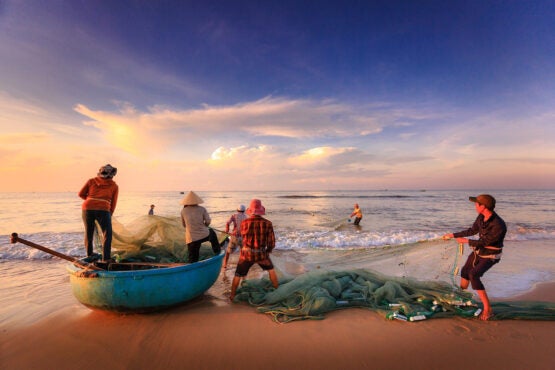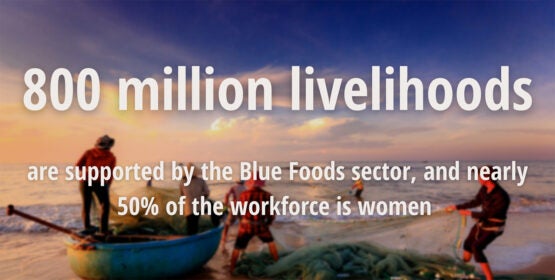Diversity of small-scale fisheries and aquaculture makes them more resilient innovative, equitable and sustainable
Despite their massive economic and nutritional contributions, small-scale fisheries and aquaculture are often overlooked by policymakers. Drawing on profiles from around the world, researchers at Stanford and other institutions provide a blueprint for tailoring effective policy to this diverse sector.
When the COVID-19 pandemic idled industrial fishing fleets and processing plants last year, many small-scale fisheries and aquaculture operations managed to stay afloat, providing livelihoods for millions of people and sustenance for many more. A new study led by researchers at Stanford and other institutions around the world reveals how the diversity of these artisanal, often family-run businesses makes them not only highly resilient to global shocks such as a pandemic, but also uniquely innovative, equitable and sustainable.
The analysis, published Sept. 15 in Nature Food, comes as the sector faces growing threats to its existence, and includes a range of recommendations aimed at reversing a history of policies that marginalize smaller producers and favor major corporate players.
“The pandemic has been a giant shock to our global food system,” said study co-lead author Fiorenza Micheli, the David and Lucile Packard Professor of Marine Science in the School of Humanities and Sciences and co-director of the Stanford Center for Ocean Solutions and Hopkins Marine Station. “Small-scale fishery and aquaculture operations have proven their resilience and value, but they still need help to thrive amid environmental and economic changes.”
Blue foods – aquatic animals, plants and algae – and the systems for harvesting, processing and marketing them are a cornerstone of many rural and national economies, supporting hundreds of millions of livelihoods. Small-scale fisheries and aquaculture provide 90 percent of the jobs in the sector and two-thirds of all the blue foods we eat.
Despite their nutritional and economic importance, these operations are often overlooked and unsupported by national and international policies related to food, development and environment. Micheli and her coauthors tie the failure to a broad misconception that all small-scale blue food operations are either poor, dysfunctional or overly vulnerable in some way. This leads to policies that fail to consider diverse characteristics, conditions and needs, making the sector especially vulnerable to resource overexploitation, habitat degradation, illegal activities and other threats.
“We need a shift of focus from narrow financial support for harmful, industrial blue food production to broader supportive structures aimed at small-scale producers who we continue to hugely under-value for their contribution to the economy and nutritional security,” said study co-lead author Rebecca Short of the Stockholm Resilience Centre.
To lay the groundwork for such a shift, the researchers drew on 70 case studies from around the world, ranging from caviar farmers in Uruguay who export to a global luxury market to women in Fiji who fish for mud crabs to sell to neighbors. The diversity of operations and their needs came into even sharper focus when assessed according to a framework of attributes – such as investment level, diversity of products and distance to consumers – that the researchers developed. This framework provides the basis for understanding how different small-scale fishery and aquaculture operations are affected by threats such as climate change, and how specific policies might affect them.
“By shedding light on the diverse roles and contributions of such fishers and farmers, we can help raise their profile and set the stage for targeted policy interventions to sustain them into the future,” said study co-lead author Lucie Hazen, a research analyst at the Stanford Center for Ocean Solutions.
The analysis found that small-scale fishery and aquaculture operations play a vital role in ensuring the global food systems are resilient, innovative, sustainable and equitable. For example, families or individuals without access to funding or technologies can still make a living in the sector with the most basic equipment, such as a basket to carry fish to the market. There are many opportunities to innovate, as in the examples of Latin American fishing cooperatives that have developed new products and processing methods for clams, sea urchins and other marine invertebrates, improving their market value and reach.
Small-scale operations also tend to be more environmentally friendly than industrial efforts for a variety of reasons, including lower fuel use and land and water rights that keep them focused on conserving resources in a single place rather than depleting one fishing ground after another.
“The framework provides a scalable approach which can ideally contribute to change dominant narratives which have tended to homogenize small-scale sectors as dysfunctional, vulnerable and/or marginal,” said study co-lead author Stefan Gelcich of Pontificia Universidad Católica de Chile.
The COVID-19 pandemic provides a compelling example of the sector’s resilience and adaptability, according to the researchers. While larger, less flexible operations went quiet, many people were still able to make a living by selling door to door via social media or other direct channels. Still, the pandemic shutdown of supply chains and markets has taken a toll on small-scale blue food purveyors who often lack the political recognition needed for protection from supportive and enabling responses such as curfew exemptions, according to the study.
Political recognition is the first step toward a slate of long-overdue policy actions – from redressing power inequalities to constraining monopolies – according to the researchers.
“We hope our work gives policymakers the tools to create radical change,” said Micheli. “It is critical to encourage and support the diversity of small-scale actors, ensuring technology, investments, diversification and development can enable them to continue feeding millions of people into the future.”
Micheli is also a senior fellow at the Stanford Woods Institute for the Environment.
This work was also undertaken as part of the CGIAR Research Program on Fish Agri Food Systems, led by WorldFish and supported by contributors to the CGIAR Trust Fund. Other funders for this research include ANID-Iniciativa Cientifica Milenio, the European Union’s Horizon 2020 research and innovation programme, the National Science Foundation; BioOce, the Nippon Foundation Ocean Nexus Program, Earthlab, the University of Washington, the Ehrling-Person Family Foundation, the Inter-American Institute for Global Change Research, the John and Katie Hansen Family Foundation, the European Research Council and the China Blue Sustainability Institute. The study is part of the Blue Food Assessment, an international joint initiative to support decision-makers in evaluating trade-offs and implementing solutions to build healthy, equitable and sustainable food systems. The assessment is funded by The Builders Initiative, the MAVA Foundation, the Oak Foundation, the Gordon and Betty Moore Foundation and the Walton Family Foundation.
To read all stories about Stanford science, subscribe to the biweekly Stanford Science Digest.


